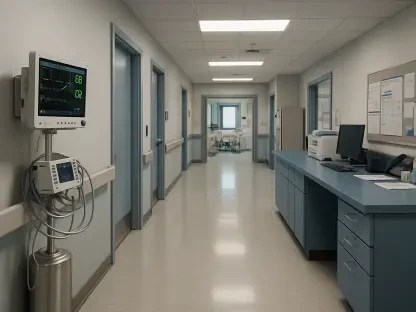Fixed version:
In the intricate and often overwhelming world of cancer treatment, patients frequently find themselves lost in a labyrinth of medical decisions, emotional turmoil, and financial strain, yearning for a guiding hand to lead them through the chaos. Care navigation in oncology emerges as a beacon of hope, promising a structured approach to support that not only addresses clinical needs but also tackles the non-clinical burdens that weigh heavily on those diagnosed with cancer. Imagine a healthcare system where isolation is replaced with connection, where unnecessary hospital visits are curtailed, and where the crushing costs of care are significantly alleviated. This transformative potential of care navigation lies in its patient-centered focus, aligning the goals of value-based care with tangible improvements in outcomes and experiences. By bridging gaps in coordination and communication, it offers a lifeline to patients and providers alike, redefining how oncology support can be delivered with empathy and efficiency.
Navigating the Oncology Landscape
Patient Struggles and Isolation
The journey through cancer care often leaves patients feeling like they’re navigating uncharted territory without a map or compass to guide them through the myriad challenges they face. Startling statistics reveal the depth of this struggle: a mere 12% of adults feel confident in managing their cancer treatment independently, while over 50% report profound isolation during diagnosis and therapy. This emotional burden is compounded by a reluctance to communicate, as 38% of patients on active treatment avoid reporting symptoms to spare their physicians additional stress. Beyond the emotional toll, the financial impact is staggering, with 42% of patients facing catastrophic costs that threaten their stability. Care navigation steps into this void as a critical intervention, providing both clinical guidance and emotional support to ensure that patients no longer feel alone or overwhelmed by the weight of their diagnosis and its implications.
Another dimension of patient challenges lies in the logistical barriers that complicate access to timely care and exacerbate feelings of helplessness during an already difficult time. Many individuals struggle to coordinate appointments, understand treatment plans, or access resources that could alleviate their burdens, often leading to delays in critical interventions. The lack of a centralized support system means that patients frequently miss out on essential services or fail to address emerging symptoms before they escalate into emergencies. Care navigation offers a solution by assigning dedicated navigators who act as advocates, helping to streamline communication between patients and healthcare teams. This personalized approach not only reduces logistical friction but also fosters a sense of trust and security, ensuring that patients feel supported at every step of their journey through the complex healthcare maze.
Institutional Inefficiencies
Healthcare institutions grapple with systemic issues that hinder effective oncology care delivery, often resulting in inflated costs and compromised patient outcomes that demand urgent attention. One glaring problem is the exorbitant cost of end-of-life care, averaging $74,000 in the final six months of a patient’s life, much of which stems from misaligned priorities and lack of coordination. Additionally, over half of cancer patients experience emergency department (ED) visits that could have been prevented with better oversight and timely interventions. These inefficiencies drain resources, burden providers, and ultimately diminish the quality of care delivered. Care navigation presents a framework to address these shortcomings by enhancing coordination among patients, providers, and payers, aiming to minimize wasteful spending and ensure that resources are directed where they are most needed.
Compounding these financial strains are the operational challenges within healthcare systems, where fragmented communication and limited resources often lead to suboptimal care delivery and missed opportunities for improvement. Providers frequently lack the time or tools to proactively monitor patient conditions, resulting in reactive rather than preventive care strategies that could save both lives and costs. The absence of streamlined processes means that critical information can slip through the cracks, contributing to avoidable hospital readmissions and prolonged treatments. By integrating care navigation into institutional practices, healthcare systems can establish clearer pathways for patient management, reducing the incidence of unnecessary ED visits and aligning care delivery with value-based principles. This shift not only eases the burden on overworked staff but also fosters a more sustainable model of oncology care that prioritizes long-term outcomes over short-term fixes.
Unlocking the Power of Proactive Navigation
Improved Outcomes and Quality of Life
Proactive care navigation stands as a proven catalyst for transforming oncology support, delivering measurable improvements in patient health and well-being through innovative, patient-centered strategies. Research published in reputable sources like the Journal of Clinical Oncology demonstrates that monitoring patient-reported symptoms can significantly enhance health-related quality of life, a critical factor in enduring the rigors of cancer treatment. Beyond comfort, this approach has been shown to reduce ED admissions by catching issues before they escalate into crises, ensuring that patients receive timely interventions. Perhaps most striking is the evidence suggesting that such proactive measures can boost overall survival rates, in some cases matching the impact of cutting-edge systemic therapies. This underscores the profound potential of navigation to not only support but also extend lives through attentive, responsive care.
Equally important is the way proactive navigation fosters a deeper connection between patients and their care teams, creating an environment where concerns are addressed before they become overwhelming obstacles to recovery. By employing tools like regular check-ins and symptom tracking, navigators can identify subtle changes in a patient’s condition that might otherwise go unnoticed until they require urgent attention. This early detection allows for adjustments in treatment plans or supportive care measures that preserve patient stability and prevent deterioration. Furthermore, the emotional reassurance of having a dedicated advocate can alleviate the psychological strain of cancer, empowering patients to engage more actively in their care. Such a holistic approach ensures that the benefits of navigation extend beyond clinical metrics, touching on the human elements of healing that are often overlooked in traditional models of oncology support.
Cost Savings and Efficiency
The financial advantages of proactive care navigation are as compelling as the clinical benefits, offering a dual impact that reshapes the economic landscape of oncology care for patients and systems alike. Studies indicate that proactive outreach initiatives can lower costs by $300 to $400 per member per month, a significant reduction that eases the burden on both individuals and payers grappling with escalating healthcare expenses. These savings are achieved by preventing costly ED visits and hospitalizations through timely interventions that address issues at their source. Additionally, the streamlined processes inherent in navigation save valuable time for providers, allowing them to focus on delivering high-quality care rather than navigating administrative complexities. This efficiency translates into a more sustainable model of care that prioritizes value over volume.
Delving deeper into the mechanics of these cost reductions reveals how navigation optimizes resource allocation, ensuring that limited healthcare dollars are spent where they yield the greatest impact on patient outcomes. By reducing the frequency of avoidable medical encounters, navigation frees up hospital beds and staff hours for those with acute needs, enhancing overall system capacity. Moreover, the emphasis on preventive care means that patients are less likely to require expensive, intensive treatments down the line, further curbing long-term expenditures. For payers, this translates into more predictable costs and improved risk management, while patients benefit from reduced out-of-pocket expenses that can otherwise lead to financial ruin. The ripple effect of these efficiencies highlights care navigation as not just a clinical tool, but a fiscal strategy that aligns the interests of all stakeholders in the oncology ecosystem toward a common goal of affordability and effectiveness.
Building a Better Future for Oncology Care
Tools and Strategies for Effective Navigation
Implementing effective care navigation in oncology relies on a suite of targeted tools and strategies designed to address the unique needs of patients while enhancing overall care coordination across diverse settings. Electronic patient-reported outcome (ePRO) surveys stand out as a powerful mechanism, reducing the risk of ED visits by an impressive 40% through consistent symptom monitoring that catches potential issues early. Clear transitions of care from hospital to clinic settings are equally vital, preventing readmissions by ensuring seamless communication and follow-up after discharge. For patients with advanced cancer, advance care planning provides clarity and dignity, aligning treatments with personal values. Additionally, addressing unmet social needs—such as transportation or nutritional support—ensures that barriers beyond medical care do not impede recovery, tailoring assistance to individual circumstances without overwhelming those who require minimal intervention.
Another critical aspect of these interventions is their adaptability, allowing care navigation to meet patients precisely where they are in their journey, whether they need intensive support or just occasional guidance to navigate their treatment path. The use of ePRO surveys, for instance, can be scaled based on patient risk profiles, focusing resources on those most likely to experience complications while sparing others unnecessary oversight. Similarly, care transitions are customized to account for varying levels of provider involvement and patient mobility, ensuring no one falls through the cracks during vulnerable periods. Advance care planning, meanwhile, opens a dialogue that empowers patients to make informed decisions long before crises emerge, reducing stress for families and providers alike. By weaving these strategies into a cohesive framework, care navigation not only addresses immediate challenges but also builds resilience against future uncertainties in the oncology care continuum.
Overcoming Implementation Barriers
The path to integrating robust care navigation into oncology is fraught with financial and technological barriers that require innovative solutions to ensure sustainable and widespread adoption across healthcare systems. Staffing costs, the development of ePRO platforms, and the establishment of analytics infrastructure represent significant investments that can strain budgets, particularly for smaller practices or underfunded institutions. Payment models offer some relief, with options like navigation billing codes—providing $82 for 30 minutes of principal care management under certain Medicare plans—alongside free work or risk-based contracts that tie economic incentives to outcomes. However, securing consistent payer support remains a challenge, often leaving gaps in funding that hinder scalability. These hurdles demand creative approaches to resource allocation and reimbursement to make navigation a viable component of standard care.
Technology, particularly artificial intelligence (AI), emerges as a transformative ally in overcoming these barriers, offering tools to manage costs and enhance efficiency in ways previously unimaginable within oncology support structures. AI applications range from automating incoming call handling to summarizing complex medical records, freeing up human resources for direct patient interaction. Moreover, AI can improve risk stratification by identifying patients most likely to need intensive support, ensuring that efforts are focused where they matter most. This not only reduces operational expenses but also amplifies the impact of navigation programs by aligning interventions with actual need. As payment models evolve to better accommodate navigation services and technology continues to advance, the financial and logistical obstacles of implementation can be progressively dismantled, paving the way for a future where care navigation is an integral, accessible part of oncology care for all who need it.









